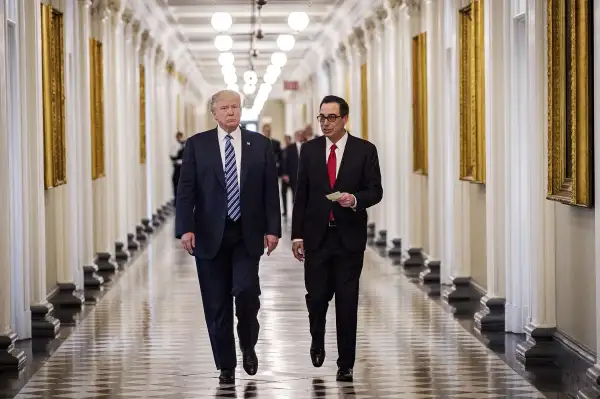Trump Is About to Unveil His New Tax Plan. Here Are 3 Questions It Needs to Address
Money is not a client of any investment adviser featured on this page. The information provided on this page is for educational purposes only and is not intended as investment advice. Money does not offer advisory services.

With his administration still looking for a big policy win, President Trump has promised a big tax announcement on Wednesday.
Cutting taxes was one of Trump's biggest campaign promises, and it's key to his vision of re-invigorating the economy. But taxes are no less complicated than healthcare, where Republicans quickly foundered — and it's not at all clear what kind of plan Trump will actually unveil, as he outlined no fewer than three different tax plans during the campaign. (His administration will also have to contend with Republicans in Congress, who have put forward their own plan.)
While Trump's Twitter promise was of "Big TAX REFORM AND TAX REDUCTION," others have suggested it may be more along the lines of a statement of principles. Still experts will be looking closely to see if it how, if at all, it addresses the big unanswered questions surrounding Trump's tax policy.
Here is what to look for when Trump unveils his new plan.
Will It Increase the Deficit?
When Barack Obama was president, Trump and other Republicans harped relentlessly on the swelling federal debt, which is expected to hit $15 trillion next year and nearly $25 trillion by 2027. Tax cuts, which both Trump and Congressional Republicans promised during the campaign, could exacerbate the situation, since the government would be collecting even less revenue to meet its financial obligations.
That means Trump and his GOP allies face a difficult choice between two competing priorities: balancing the budget and handing money back to taxpayers. And while an Obamacare repeal might have slashed both government healthcare spending and taxes on the wealthy, giving a leg up to any new tax reform plan, that effort's failure gives Republicans much less room to maneuver.
There is a chance that President Trump may simply declare his plan "revenue neutral," meaning it doesn't add to the deficit, no matter what the number are -- as he and his surrogates have done in the past. Take that with a grain of salt, says Howard Gleckman, senior fellow at the centrist Tax Policy Center. While cutting taxes can spur economic growth, that extra growth is typically not dramatic enough to fill budget gaps created by the drop in revenue, he says. "Instead," he notes, "look for specific proposals for raising specific taxes to offset the cuts."
Will It Give Investors a Boost?
Cutting corporate taxes is another top Republican goal. Politicians on both sides of the aisle bemoan our byzantine corporate income tax system, which levies a top 35% rate -- among the highest in the world -- but is also so riddled with loopholes and exclusions that some companies pay close to full freight and others nothing at all.
While many in Washington would like to change the system, there is still no consensus on how to do it. Earlier this year, House Speaker Paul Ryan proposed a dramatic overhaul that would replace the current tax on profits with a 20% tax on cash flow. Yet Ryan's plan, which also involves a confusing exemption for exports, is untested; meanwhile, some politically powerful industries, like retailers and automakers, have already started lobbying against it.
Early word this week suggests Trump may be committed to going a different route, seeking a more traditional tax structure with a 15% rate. Either way, expected cuts in corporate taxes are a big reason the stock market has rallied since Trump's election victory, although whether there's room for more growth is an open question.
Does It Help the Middle Class?
Of course, what most voters want from Trump's tax plan are cuts for the middle class. During last year's campaign, both Trump and Ryan proposed collapsing the number of brackets from seven to three -- with tax rates of 12%, 25%, and 33% -- and there is a good chance that Trump's new tax plan will reiterate that pledge.
What hasn't been settled, however, is where those brackets will be set. Taxpayers in the current top 39.6% bracket are likely to get good news; they've got nowhere to go but down. But below that, it's a lot less clear. In Trump's campaign plan, for instance, the top 33% bracket would begin at the $127,500 threshold for single filers, while under the Ryan plan it would not kick until a much higher $202,150. For 2016, under the current system, the 33% marginal tax bracket affected single filers making at least $200,500.
Another wild card is what to do with popular deductions. Trump is likely to target at least some tax perks to help offset the cost of lower rates. But which ones is still an open question. During the campaign, he proposed capping the value of deductions across the board for wealthier filers -- limiting their value to $100,000 for singles and $200,000 for couples. Or he could tackle the deductions individually: Eliminating the mortgage interest deduction alone could give Washington up to $75 billion a year; deductions for charitable giving, meanwhile, cost the U.S. government $47 billion.
Still, experts say the tax perk with the biggest target on its back is the deduction for state and local taxes. It costs $50 billion a year, and mostly benefits taxpayers in places with hefty state tax burdens -- particularly deep blue states like New York, California, and Illinois.
